Brake Caliper Replacement Front, Bendix
Removal Procedure
- Apply the parking brake.
- Block the vehicle wheels.
- Tilt the cab.
- Remove about 2/3 of the brake fluid from the master cylinder reservoir.
- Raise the vehicle. Support the vehicle with safety stands. Refer to Lifting and Jacking the Vehicle .
- Remove the tires and wheels. Refer to Tire and Wheel Removal and Installation (Front) .
- Remove the brake caliper retainer screw (1).
- Remove the brake caliper retainer (3) and the brake caliper spring (2) using a brass punch.
- Compress the pistons.
- Use a C-clamp between the inner brake caliper housing and the outer brake pad.
- Use screwdrivers in order to pry between the outer brake caliper housing and the outer brake pad.
- While compressing the pistons, watch the reservoir for possible brake fluid overflow. The inner brake pad may stay on the brake caliper mounting plate (Bendix® caliper).
- Remove the wheel speed sensor. Refer to in Wheel Speed Sensor Replacement in Antilock Brakes.
- Disconnect the brake hose.
- Cap or tape the brake hose fitting in order to prevent contamination.
- Remove the front brake hose.
- Remove the brake caliper.
| • | Do not completely drain the master cylinder reservoir. |
| • | Drain the fluid from the brake caliper bleeder valve. |
| • | Drain the fluid into a suitable container. Discard the fluid. |

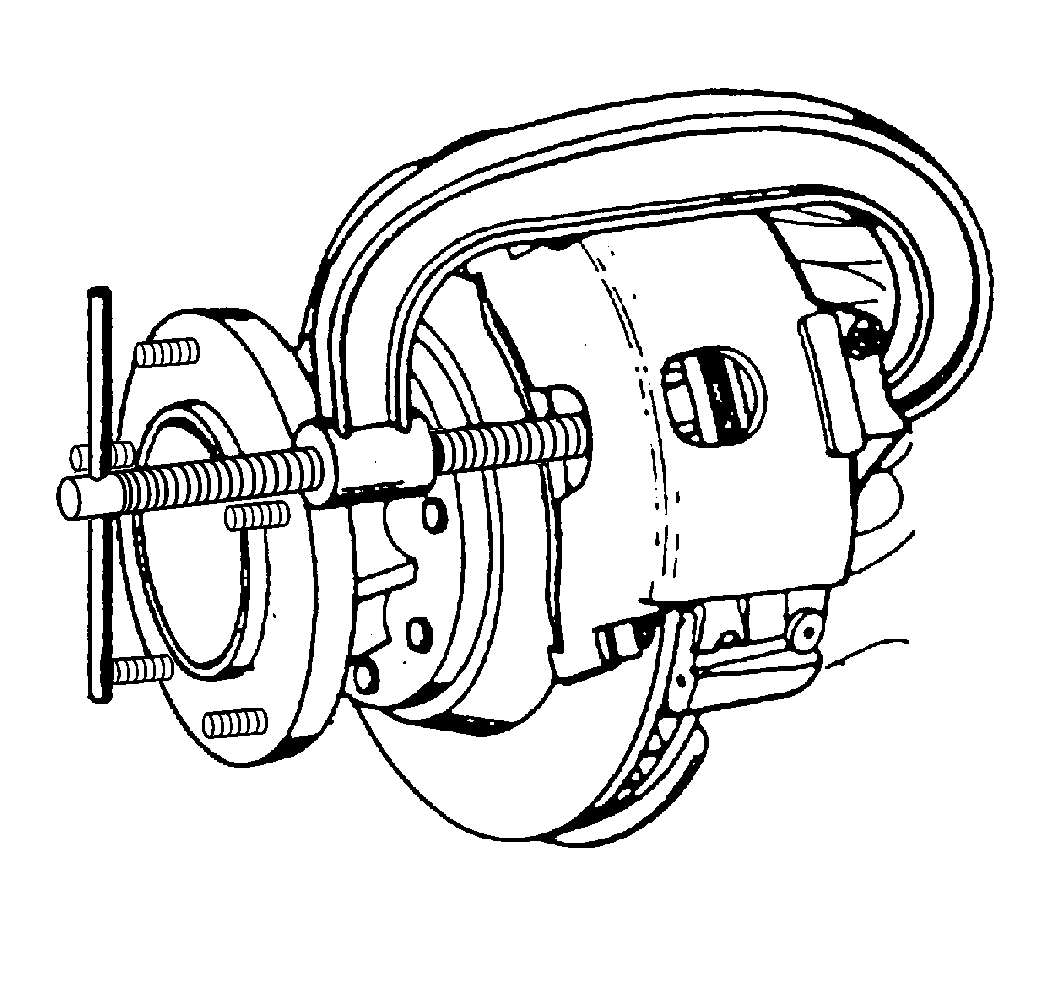
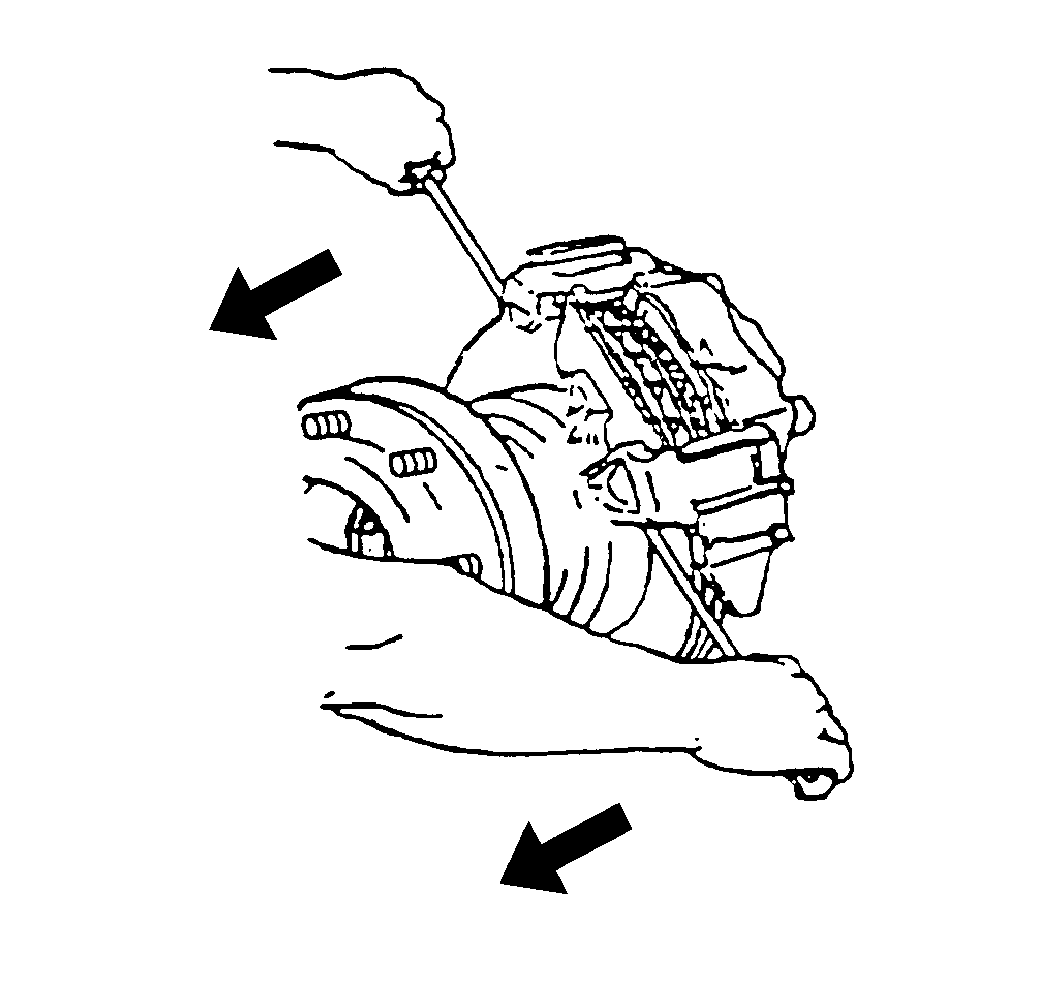
Notice: Do not allow calipers to hang from the flexible hoses. Doing so can damage the hoses.
Important:
• Do not let the brake caliper hang from the brake hose. Suspend
the brake caliper with a wire or cord. • It is not always necessary to remove the brake hose from the brake
caliper when replacing the brake pad assemblies. • Clean the area around the brake hose on the brake caliper. • Cap or tape the fitting in order to prevent dirt from entering
the brake hose.
Inspection Procedure
- Inspect the inside of the brake caliper for brake fluid leaks. If you find a leak, overhaul the brake caliper. Refer to Brake Caliper Overhaul .
- Inspect the piston seal for leaks and brake fluid around the dust boot, the heat shield, and the inboard brake pad.
- Inspect the dust boots for any damage. If you find damage, overhaul the brake caliper. Refer to Brake Caliper Overhaul .
- Inspect the support rail surfaces on the brake caliper.
- Inspect the support rail surfaces on the brake caliper mounting plate.
- Inspect the V-way surfaces on the brake caliper and the support rail surfaces on the brake caliper mounting plate.
- Inspect the heat shields. If the heat shields are loose, replace the shields.
- Inspect under the dust boots for leakage. If you find leakage, overhaul the brake caliper. Refer to Brake Caliper Overhaul .

Installation Procedure
- Clean the support rail surfaces of the brake caliper with a wire brush. File smooth any deep nicks or gouges.
- Clean the support rail surfaces of the brake caliper mounting plate with a wire brush. File smooth any deep nicks or gouges.
- Apply a thin coat of Brake Caliper Lubricant to the brake caliper mounting plate support rail surfaces.
- Install the brake caliper pistons to the bottom of the bores. If the piston cannot be pushed by hand, place a small block of wood over the pistons and the boots. Use a C-clamp around the wood block and brake caliper housing in order to push in the pistons.
- Install the brake caliper.
- Loosely assemble the brake hose nut to the brake caliper.
- Loosely assemble the brake hose bracket to the brake caliper.
- Install the wheel speed sensor. Refer to in Wheel Speed Sensor Replacement in Antilock Brakes.
- Select a shim. Refer to Brake Caliper and Anchor Plate Wear Adjustment .
- Apply a thin coat of Brake Caliper Lubricant to the brake caliper retainer and the brake caliper spring.
- Tap the brake caliper retainer and brake caliper spring into place using a brass punch and a light weight hammer. The hose in the brake caliper retainer should line up with the threaded hole in the brake caliper mounting plate.
- Install the brake caliper retainer bolt.
- Fill the master cylinder reservoir with brake fluid. Refer to in Hydraulic Brakes.
- Bleed the hydraulic brake system. Refer to Hydraulic Brakes.
- Pump the brake pedal several times in order to ensure that the pedal is firm and the brake linings are adjusted.
- Install the tires and wheels. Refer to Tire and Wheel Removal and Installation (Front) .
- Lower the vehicle. Refer to Lifting and Jacking the Vehicle .
- Remove the blocks.
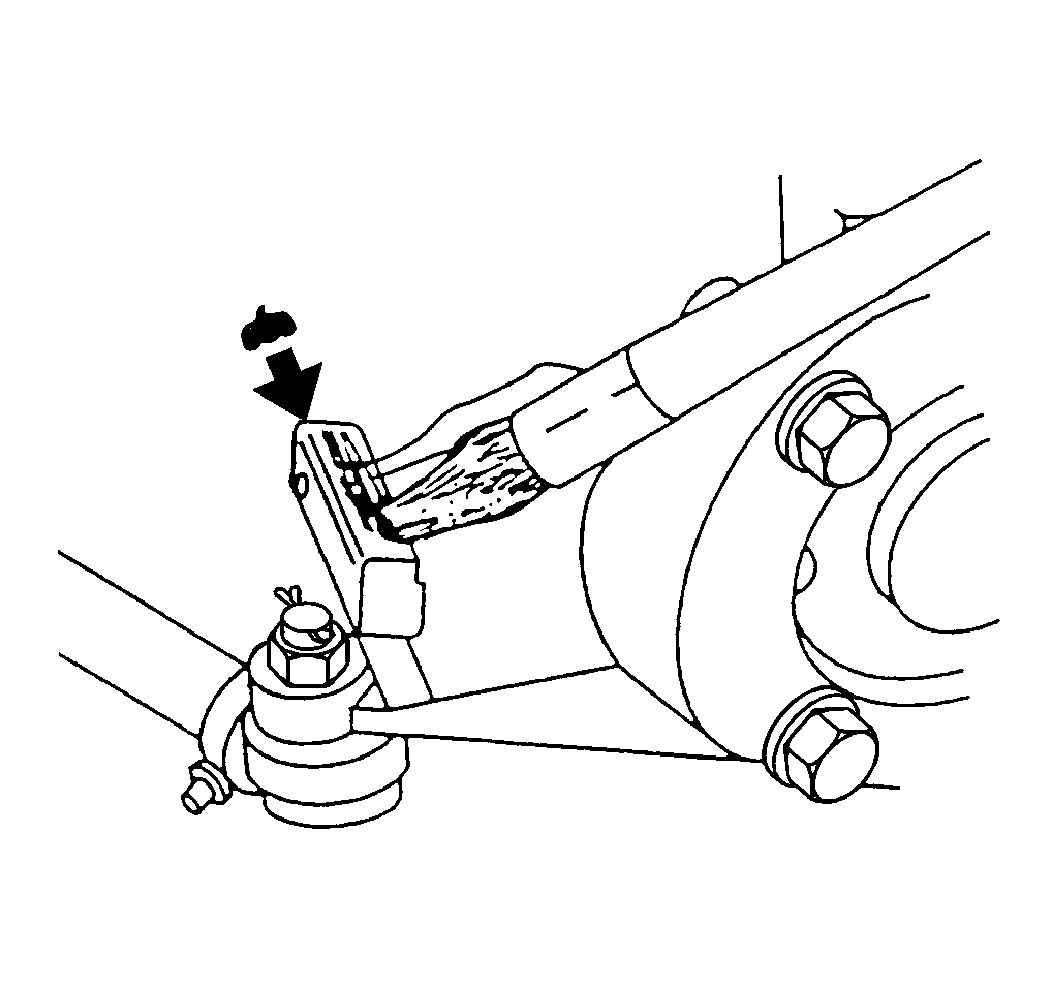
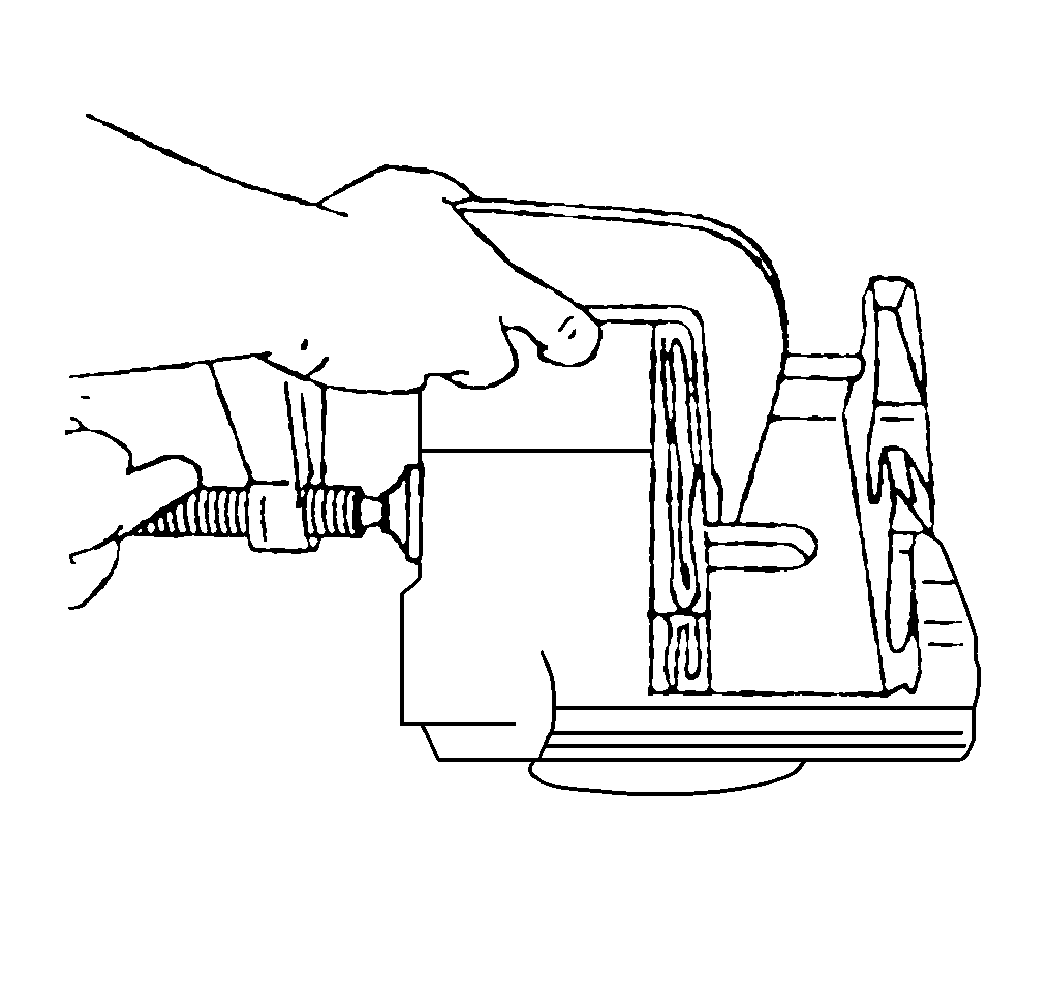
Important: Never drive the pistons into the bores with a mallet or metal tools.
Notice: Make sure the brake hose is not twisted or kinked after installation. Damage to the hose could result.
Notice: Use the correct fastener in the correct location. Replacement fasteners must be the correct part number for that application. Fasteners requiring replacement or fasteners requiring the use of thread locking compound or sealant are identified in the service procedure. Do not use paints, lubricants, or corrosion inhibitors on fasteners or fastener joint surfaces unless specified. These coatings affect fastener torque and joint clamping force and may damage the fastener. Use the correct tightening sequence and specifications when installing fasteners in order to avoid damage to parts and systems.
Tighten
| • | Tighten the brake hose nut to 19 N·m (14 lb ft). |
| • | Tighten the brake hose bracket bolts to 32 N·m (24 lb ft). |

Important: The brake caliper retainer bolt boss must fit in the circular hole in the brake caliper retainer.
Important: Do not reuse the brake caliper retainer bolt more than 4 times.
Tighten
Tighten the brake caliper retainer bolt to 40 N·m (29 lb ft).
Important: Check the fluid level in the master cylinder reservoir after pumping the brake pedal.
Caution: Do not move the vehicle until a firm brake pedal is obtained. Air in the brake system can cause the loss of brakes with possible personal injury.
Brake Caliper Replacement Front, Dayton-Walther
Removal Procedure
- Apply the parking brake.
- Block the vehicle wheels.
- Remove about 2/3 of the brake fluid from the master cylinder reservoir.
- Raise the vehicle. Support the vehicle with safety stands. Refer to Lifting and Jacking the Vehicle in General Information.
- Remove the tires and wheels. Refer to Tire and Wheel Removal and Installation (Front) .
- Remove the brake caliper retainer bolt (1).
- Remove the brake caliper retainer (6) and brake caliper spring (2) using a brass punch.
- Compress the pistons.
- Use a C-clamp between the inner brake caliper housing and the outer brake pad.
- Use screwdrivers to pry between the outer brake caliper housing and the outer brake pad.
- While compressing the pistons, watch the reservoir for possible brake fluid overflow.
- Remove the wheel speed sensor. Refer to Wheel Speed Sensor Replacement in Antilock Brakes.
- Disconnect the brake hose.
- Cap or tape the brake hose fitting in order to prevent contamination.
- Remove the brake caliper.
| • | Do not completely drain the master cylinder reservoir. |
| • | Drain the fluid from the brake caliper bleeder valve. |
| • | Drained the fluid into a suitable container. Discard the fluid. |
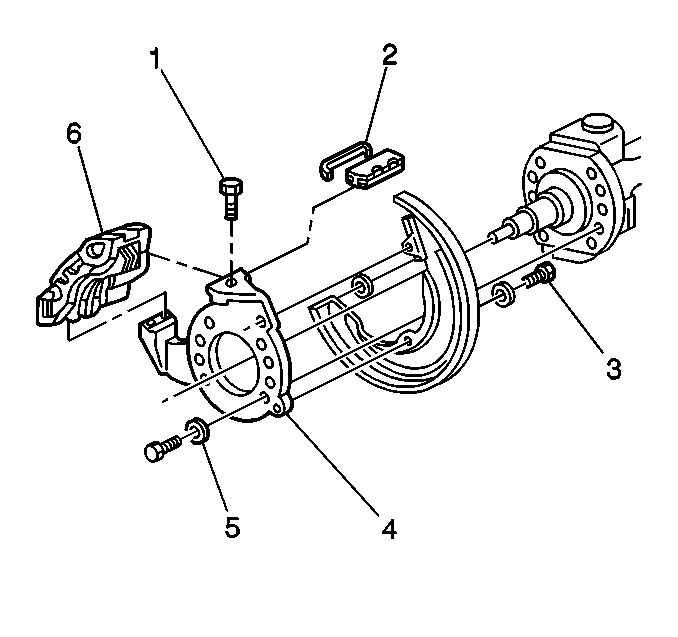


Notice: Do not allow calipers to hang from the flexible hoses. Doing so can damage the hoses.
Inspection Procedure
- Clean the area around the brake hose on the brake caliper.
- Inspect the inside of the brake caliper for brake fluid leaks. If you find a leak, overhaul the brake caliper. Refer to Brake Caliper Overhaul .
- Inspect the piston seal for leaks and brake fluid around the dust boot, the heat shield, and the inboard brake pad.
- Inspect the dust boots for any damage. If you find damage, overhaul the brake caliper. Refer to Brake Caliper Overhaul .
- Inspect the V-way surfaces on the brake caliper.
- Inspect the V-way surfaces on the brake caliper mounting plate.
- Inspect the heat shields. If the heat shields are loose, replace the shields.
- Inspect under the dust boots for leakage. If you find leakage, overhaul the brake caliper. Refer to Brake Caliper Overhaul .

Installation Procedure
- Clean the V-way surfaces of the brake caliper with a wire brush. File smooth any deep nicks or gouges.
- Clean the support rail surfaces of the brake caliper mounting plate with a wire brush. File smooth any deep nicks or gouges.
- Apply a thin coat of Brake Caliper Lubricant to the brake caliper mounting plate support rail surfaces.
- Install the pistons into the bottom of the caliper bores.
- Install the brake caliper.
- Install the brake hose.
- Loosely assemble the brake hose nut to the brake caliper.
- Loosely assemble the brake hose bracket to the brake caliper.
- Install the wheel speed sensor. Refer to in Wheel Speed Sensor Replacement in Antilock Brakes.
- Refer to Brake Caliper and Anchor Plate Wear Adjustment .
- Apply a thin coat of Brake Caliper Lubricant to the brake caliper retainer and the brake caliper spring.
- Tap the brake caliper retainer (6) and brake caliper spring (2) into place using a brass punch and a light weight hammer. The hose in the brake caliper retainer should line up with the threaded hole in the brake caliper mounting plate (4).
- Install the brake caliper retainer bolt.
- Fill the master cylinder reservoir with brake fluid. Refer to Hydraulic Brakes.
- Bleed the hydraulic brake system. Refer to Hydraulic Brakes.
- Pump the brake pedal several times in order to ensure that the pedal is firm and the brake linings are adjusted.
- Install the tires and wheels. Refer to Tire and Wheel Removal and Installation (Front) .
- Lower the vehicle. Refer to Lifting and Jacking the Vehicle .
- Remove the blocks.
- Release the parking brake.


Important: Never drive the pistons into the bores with a mallet or metal tools.
If you cannot push the completely pistons into the bores by hand, place a small block of wood over the pistons and dust boots. Use a C-clamp around the wooden block and brake caliper housing in order to push in the pistons.
Notice: Make sure the brake hose is not twisted or kinked after installation. Damage to the hose could result.
Notice: Use the correct fastener in the correct location. Replacement fasteners must be the correct part number for that application. Fasteners requiring replacement or fasteners requiring the use of thread locking compound or sealant are identified in the service procedure. Do not use paints, lubricants, or corrosion inhibitors on fasteners or fastener joint surfaces unless specified. These coatings affect fastener torque and joint clamping force and may damage the fastener. Use the correct tightening sequence and specifications when installing fasteners in order to avoid damage to parts and systems.
Tighten
| • | Tighten the brake hose nut to 19 N·m (14 lb ft). |
| • | Tighten the brake hose bracket bolts to 32 N·m (24 lb ft). |

Important: The brake caliper retainer bolt boss must fit in the circular hole in the brake caliper retainer.
Important: Do not reuse the brake caliper retainer bolt more than 4 times.
Tighten
Tighten the brake caliper retainer bolt to 40 N·m (29 lb ft).
Important: Check the fluid level in the master cylinder reservoir after pumping the brake pedal.
Caution: Do not move the vehicle until a firm brake pedal is obtained. Air in the brake system can cause the loss of brakes with possible personal injury.
Brake Caliper Replacement Rear, Rail Slider
Removal Procedure
- Apply the parking brake.
- Block the vehicle wheels.
- Tilt the cab.
- Remove about 2/3 of the brake fluid from the master cylinder reservoir.
- Raise the vehicle. Support the vehicle with safety stands. Refer to Lifting and Jacking the Vehicle .
- Remove the tires and wheels. Refer to Tire and Wheel Removal and Installation (Dual/Rear) .
- Remove the brake caliper retainer screw .
- Remove the brake caliper retainer and the brake caliper spring (11) using a brass punch.
- Compress the pistons.
- Use a C-clamp between the inner brake caliper housing and the outer brake pad.
- Use screwdrivers in order to pry between the outer brake caliper housing and the outer brake pad.
- While compressing the pistons, watch the reservoir for possible brake fluid overflow. The inner brake pad may stay on the brake caliper mounting plate (Bendix® caliper).
- Remove the wheel speed sensor. Refer to in Wheel Speed Sensor Replacement in Antilock Brakes.
- Disconnect the brake hose.
- Remove the brake hose.
- Remove the brake caliper.
| • | Do not completely drain the master cylinder reservoir. |
| • | Drain the fluid from the brake caliper bleeder valve. |
| • | Drain the fluid into a suitable container. Discard the fluid. |
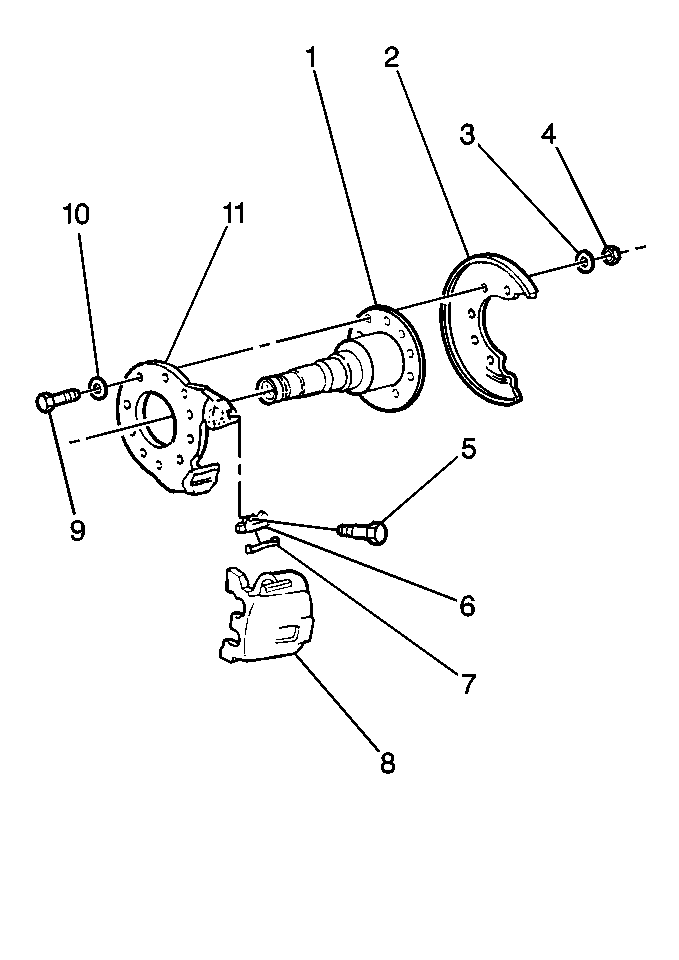


Notice: Do not allow calipers to hang from the flexible hoses. Doing so can damage the hoses.
Important:
• Do not let the brake caliper hang from the brake hose. Suspend
the brake caliper with a wire or cord. • Removing the brake hose from the brake caliper when replacing
the brake pad assemblies is not always necessary. • Clean the area around the brake hose on the brake caliper. • Cap or tape the fitting in order to prevent dirt from entering
the brake hose.
Inspection Procedure
- Inspect the inside of the brake caliper for brake fluid leaks. If you find a leak, overhaul the brake caliper. Refer to Brake Caliper Overhaul .
- Inspect the piston seal for leaks and brake fluid around the dust boot, the heat shield, and the inboard brake pad.
- Inspect the dust boots for any damage. If you find damage, overhaul the brake caliper. Refer to Brake Caliper Overhaul .
- Inspect the V-way surfaces on the brake caliper.
- Inspect the V-way surfaces on the brake caliper mounting plate.
- Inspect the dust shields. If the dust shields are loose, replace the shields.
- Inspect under the dust boots for leakage. If you find leakage, overhaul the brake caliper. Refer to Brake Caliper Overhaul .

Installation Procedure
- Clean the V-way surfaces of the brake caliper with a wire brush. File smooth any deep nicks or gouges.
- Clean the V-way surfaces of the brake caliper mounting plate with a wire brush. File smooth any deep nicks or gouges.
- Apply a thin coat of Brake Caliper Lubricant to the brake caliper mounting plate support rail surfaces.
- Install the brake caliper pistons to the bottom of the bores.
- Install the brake caliper.
- Install the brake hose.
- Loosely assemble the brake hose nut to the brake caliper.
- Loosely assemble the brake hose bracket to the brake caliper.
- Install the wheel speed sensor. Refer to Wheel Speed Sensor Replacement in Antilock Brakes.
- Install the brake caliper.
- Install the brake caliper retainer spring in the support rail.
- Select an appropriate shim. Refer to Brake Caliper and Anchor Plate Wear Adjustment .
- Apply a thin coat of Brake Caliper Lubricant to the brake caliper retainer and the brake caliper spring.
- Tap the brake caliper retainer (3) and brake caliper spring (2) into place using a brass punch and a light weight hammer. The hose in the brake caliper retainer should line up with the threaded hole in the brake caliper mounting plate.
- Install the brake caliper retainer screw.
- Install the brake caliper retainer bolt.
- Fill the master cylinder reservoir with brake fluid. Refer to Hydraulic Brakes.
- Bleed the hydraulic brake system. Refer to Hydraulic Brakes.
- Install the tires and wheels. Refer to Tire and Wheel Removal and Installation (Dual/Rear) .
- Lower the vehicle.
- Remove the blocks.


Important: If the piston cannot be pushed by hand, place a small block of wood over the pistons and boots. Use a C-clamp around the wood block and brake caliper housing in order to push in the pistons.
Important: Never drive the pistons into the bores with a mallet or metal tools.
Notice: Make sure the brake hose is not twisted or kinked after installation. Damage to the hose could result.
Notice: Use the correct fastener in the correct location. Replacement fasteners must be the correct part number for that application. Fasteners requiring replacement or fasteners requiring the use of thread locking compound or sealant are identified in the service procedure. Do not use paints, lubricants, or corrosion inhibitors on fasteners or fastener joint surfaces unless specified. These coatings affect fastener torque and joint clamping force and may damage the fastener. Use the correct tightening sequence and specifications when installing fasteners in order to avoid damage to parts and systems.
Tighten
| • | Tighten the brake hose nut to 19 N·m (14 lb ft). |
| • | Tighten the brake hose bracket bolts to 32 N·m (24 lb ft). |

Important: The brake caliper retainer bolt boss must fit in the circular hole in the brake caliper retainer.
Important: Do not reuse the brake caliper retainer bolt more than 4 times.
Tighten
Tighten the brake caliper retainer bolt to 40 N·m (29 lb ft).
Important: Check the fluid level in the master cylinder reservoir after pumping the brake pedal.
Pump the brake pedal several times in order to ensure that the pedal is firm and the brake linings are adjusted.Caution: Do not move the vehicle until a firm brake pedal is obtained. Air in the brake system can cause the loss of brakes with possible personal injury.
